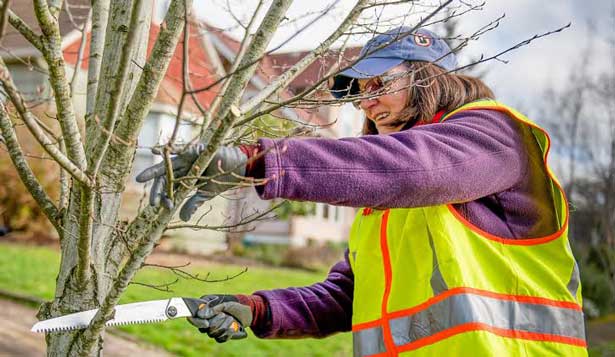Council trees are trees on public land and cannot be touched unless the council has specifically permitted you to do so.
To trim a council tree, you will first need to get permission from the Council by applying for a permit. In most cases, they will ask what the issue is and get their tree contractors to do the job free of charge.
All local councils have preferred tree cutting services that do all their tree trimming on a contract basis. By alerting them to an issue, they should respond within a reasonable time period to get the problem tree attended to.

Table of contents
ToggleWhat if the council tree is overhanging my property?
In most states, you will need to alert the council first before doing anything. If the tree was on private land, say your neighbor’s property, you could trim any branches hanging over your side of the fence, just as long as the tree was not protected.
It becomes a little dicier when it’s on public land.
Always alert the council before carrying out any work. In most cases, they will get their own contractors to do the work.
In some cities like Perth, WA, tree trimming can be carried out on trees directly in front of your house on the nature strip.
Make sure you are aware of the local tree trimming laws before you begin work.
What to do when council tree is blocking my driveway?
If it has fallen in a storm, you can cut it up and get rid of it. If it were me, I would first contact the SES and let them know a tree is blocking your driveway and you need to get out. Depending on their workload, they should be out in a few hours to do the work.
If you were to go straight to a tree service, they would charge you. They will charge double for the emergency tree services.
The SES will not remove the tree but get it out of the way and in a safe area for you to have it removed at your convenience.
Can I cut down a council tree?
It’s the same rules for removing a council tree as it is to prune one. You must first ask for council permission before proceeding.
Fines for cutting down trees on public land without prior consent. Fines range right up to $10,000 per tree.
How do I apply to council for a permit?
These days most councils have an online form that you can fill out and submit. You will first need to pay a small fee upon submission.
The fees range in price from $30 – $150 depending on the council area you live in. Permit applications fees are generally cheaper price for tree pruning than removal. They are also cheaper in areas at the lower end of the socioeconomic spectrum.
Will I need to pay for the trimming?
In Perth, WA in most cases you will need to pay for the removal or pruning costs, once permission has been granted.
You will not be paying the council, but employing your own private contractors to do the work.
In other states and cities, the council will come to the party (eventually) and have their contractors do the job. It will not cost you a cent.












